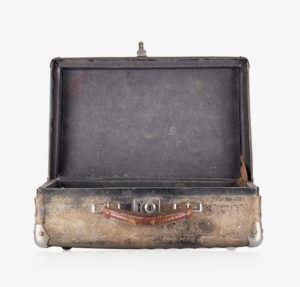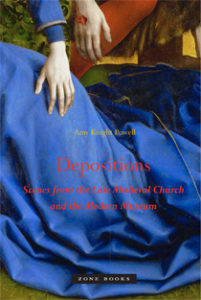A Short History of the Picture as Box
by Amy Knight Powell
The essay begins:

Paintings are small. Even those that are relatively large are still tiny compared to the world. The desire to escape this limiting condition has been integral to the history of Western painting since the Renaissance, and it has registered in talk about painting since then as well, in the dominance that the painting-as-window metaphor, with all its connotations of openness and extension, has enjoyed over the metaphor of painting-as-box, with its connotations of closure and withdrawal.
“Then it occurred to me that it could be a box in which all my works would be collected and mounted like in a small museum, a portable museum, so to speak.” This is Marcel Duchamp talking about his monographic box-in-a-suitcase, which contains sixty-nine miniature replicas, photographs, and color reproductions of his own works.
“Duchamp is involved with the notion of the manufacture of objects,” Robert Smithson chides, “so that he can have his little valise full of souvenirs.”
More willing to entertain Duchamp’s irony, Benjamin Buchloh describes Duchamp’s Box in a Valise as a critique of commodity fetishism that is still caught in fetishism’s thrall: “All the functions of the museum … are minutely contained in Duchamp’s Valise: the valorisation of the object, the extraction from context and function, … arbitrary movements in time and space, multiple ownership and privacy of possession.” The box, according to Buchloh and Smithson, is a repository for the sentimentalized and domesticated. It is made to hold discrete things and, thereby, facilitates the circulation of commodities on which capitalism depends.
Indeed, boxes travel well from place to place. (Suitcases are nothing more than boxes with the added convenience of handles. One of the ironies of Duchamp’s box-in-a-suitcase is the redoubling of this portability.) They also allow their contents to travel through time, storing them so they can be used at some later date. Each time something is boxed so it can be transported to another location, it is also readied for another occasion. With each re-opening, the contents of the box will find themselves at a temporal remove from where they were before, having missed, in a certain sense, everything that happened in between.
In this essay, I will make the case that paintings have been box-like for a long time, and that a corresponding desire to move beyond that condition has been around for a long time as well. Smithson’s and Buchloh’s disdain for the box—their preference for a more site specific and less portable and, therefore, less marketable art—is only one, relatively recent, expression of this drive. Their primary target, the modern easel picture, was already an attempt to escape the box that earlier images had inhabited, insofar as its illusionism was already a reaching for the world beyond the frame.
Seeing the longevity of this drive to escape requires taking a long and therefore necessarily cursory view. The view could in fact have been much longer. By starting my story in Europe in the late Middle Ages, I do not at all mean to suggest that this was the first time and place in which the widespread boxing of images occurred. This story could have been told on a much larger scale, both temporally and geographically. Not only is my choice of objects highly selective in this sense; it also adheres in large measure to a canon that itself entails countless exclusions. Aspects of my argument could well have been made by bringing extracanonical material to bear, but here I have wanted to work open the canon from the inside out. Continue reading …
In “The Crisis of the Easel Picture” (1948), Clement Greenberg compares the easel picture, disparagingly, to a box-like cavity cut into the wall. In this essay, I argue that late medieval panel paintings—which indeed often took the form of boxes—show Greenberg to be justified in making this comparison, if not in doing so disparagingly. But what Greenberg failed to fully acknowledge is that the easel picture had already long tried to escape this condition through the opening of the metaphor of the window. Failing to recognize this earlier effort to escape the material conditions of the box, many modernists and postmodernists, like Greenberg, attempting to move beyond the easel picture in the name of an art undivided from life, have unintentionally upheld the easel picture’s own escapist ideology.
 AMY KNIGHT POWELL is Associate Professor of Art History at the University of California, Irvine. She is the author of Depositions: Scenes from the Late Medieval Church and the Modern Museum (Zone Books, 2012).
AMY KNIGHT POWELL is Associate Professor of Art History at the University of California, Irvine. She is the author of Depositions: Scenes from the Late Medieval Church and the Modern Museum (Zone Books, 2012).
